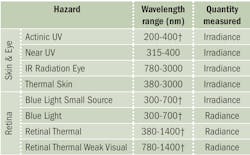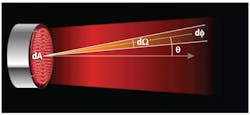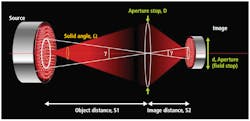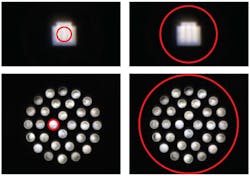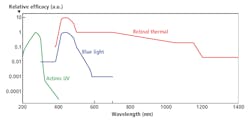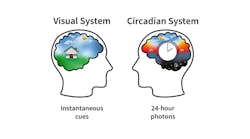+++++
This article was published in the November/December 2011 issue of LEDs Magazine.
+++++
Part one of this three-part series provided an overview of the potential hazards to the human body posed by exposure to optical radiation, and the development of international standards to evaluate the photobiological safety of non-laser sources. Here, a more practical approach is adopted, in considering the finer details of source evaluation and the implementation of safety standards in Europe and the rest of the world.
Scope of IEC62471:2006
The IEC62471:2006 standard “Photobiological Safety of Lamps and Lamp Systems” provides guidance for the evaluation of the photobiological safety of all electrically-powered, non-laser sources of optical radiation emitting in the spectral range 200-3000 nm, whether or not the emission of light is the primary purpose of the product. The inclusion of LEDs in the scope of this standard is specifically mentioned to highlight the removal of LEDs from the scope of the laser standard, IEC60825.
The potential hazards of exposure to the skin, the front surfaces of the eye (cornea, conjunctiva and lens) and the retina are evaluated through consideration of six specific hazards with respect to exposure limits (ELs) provided for an exposure duration of eight hours, taken as a working day. The standard does not consider the potential effects of long-term exposure, nor of abnormal photosensitivity.
The standard provides specific guidance on the geometrical conditions under which these measurements should be made to take into account biophysical phenomena, such as the effect of eye movements on retinal irradiation. The spectral range over which radiance should be considered is reduced to 300-1400 nm, since the retina is essentially protected outside this range due to the transmission characteristics of the lens. Table 1 indicates the required measurement (radiance or irradiance) for different hazards.
Measurement of irradiance
Irradiance permits the evaluation of hazards to the skin and front surfaces of the eye. Irradiance is defined as the ratio of radiant power (dF) incident on an element of a surface, to the area (dA) of that element (Fig. 1). Its symbol is E and its units are W/m2.
In measuring irradiance, the measurement optic, typically a diffuser or an integrating sphere, should have a cosine angular response to correctly account for off-axis contributions. At a given angle from the surface normal, the projected area on the surface is increased by the cosine of the said angle, resulting in reduced irradiance.
Knowledge of source irradiance does not however give any information about the quantity of light coupled by the eye and imaged on the retina, for which a measurement of radiance is required.
Measurement of radiance
Radiance permits the evaluation of hazards to the retina. Radiance is defined as the ratio of radiant power (dF) emitted by area dA into solid angle dΩ at angle q to the source normal, to the product of solid angle dΩ and the projected area dA∙cos q (Fig. 2). The symbol is L and the units are W/m2sr.
In viewing a source, the eye collects light within a given solid angle set by the diameter of the pupil, and projects an image of the source onto the retina. As the pupil dilates (or contracts) according to the level of visual stimulus, or luminance, of the source, the retinal irradiance of the image increases (or decreases).
The law of conservation of radiance states that radiance cannot be increased by passive optical systems such as the lens of the eye. The retinal irradiance is therefore determined from the source radiance and the solid angle subtended by the pupil (2-7-mm diameter) at the retina (17-mm distant) in the reverse of the determination of radiance from irradiance, given below.
The imaging technique (Fig. 3) replicates the imaging of the eye. A telescope images the source under test onto a plane at which may be placed apertures of varying diameter to select the required FOV of measurement.
Alternatively, a measurement of irradiance with a cosine-corrected input optic may be performed (Fig. 4). An aperture is placed directly at the source to define the measurement FOV. The radiance is computed from the ratio of irradiance to the solid angle of the FOV in steradians.
Physiological radiance
For momentary viewing, the retinal image of a source subtends the same angle as does the source. The smallest image formed on the retina, according to IEC62471, has an angular extent of 1.7 mrad, given the imperfect imaging performance of the eye.
With increasing exposure time, due to eye movement (saccades) and task-determined movement, the retinal image is smeared over a larger area of the retina, resulting in a corresponding reduction in retinal irradiance. A time-dependent function is defined to represent the spread of the retinal image in the range from 1.7 to 100 mrad. This covers the range from 0.25s (aversion response time) to 10,000s exposure.
The measured quantity is more accurately termed physiological radiance as opposed to true radiance, which by definition samples only the emitting area of the source (Fig. 5). Where the physiological radiance is measured in a FOV greater than the angle subtended by the source, the resultant radiance is an average of the true source radiance and the dark background. Furthermore, since the angular subtense of a source varies with distance, physiological radiance, unlike true radiance, is a function of measurement distance.
Spectral influence
In the above, reference was made to irradiance and physiological radiance with no consideration for the spectrum of the source, which is clearly very important within the context of this standard. These quantities should, in practice, be evaluated at each wavelength with a monochromator. This yields spectral irradiance and spectral physiological radiance. The resultant spectra should be weighted, where required, against hazard weighting functions to take account of the strong wavelength dependence of three of the hazards considered (Fig. 6). The result should be integrated over the required wavelength range prior to comparison with ELs.
Measurement distance
The distance at which a source should be evaluated depends upon its intended application. Two exposure scenarios are considered; general lighting service (GLS) and all other applications (non-GLS).
Irradiance measurements may be performed at a convenient distance and scaled to 500 lux. However, physiological radiance, which depends on the source subtense with respect to the applicable FOV, should be performed at the correct distance.
The rationale for the 500-lux condition is arbitrary and a bone of contention within the lighting industry since this in many cases does not represent a realistic exposure scenario. In the next part of this article, we shall consider how this issue is currently being addressed.
Non-GLS sources should be measured at a distance of 200 mm from the (apparent) source. This distance represents the near point of the human eye. At shorter distances than 200 mm, the retinal image is out of focus, resulting in lower retinal irradiance.
The measurement at 200 mm may represent a worst-case exposure condition for the retina. However, this is not the case for the skin and front surfaces of the eye where the exposure distance may be closer. This latter eventuality has not yet been taken into account in this standard, for which the primary concern is acute retinal damage.
Comparison with ELs
ELs are provided in terms of radiant flux for thermal hazards or energy (radiant flux multiplied by time) for photochemical hazards: a measured irradiance result can be directly compared with the former, and an exposure time obtained for the latter. This procedure does not apply to the measurement of radiance, for which the FOV of measurement is time dependent.
A pass/fail test is therefore applied to the retinal hazards based on measurements at FOVs corresponding to the minimum exposure times of the classification system in turn, starting from the exempt risk group. Where the resultant radiance exceeds the maximum-permissible radiance for a given risk group, the next risk group is tested. The detailed evaluation of retinal hazards is rather more convoluted since source size and level of visual stimulus should be taken into account in determining which ELs to apply.
Classification
As outlined in part 1 of this article series, a classification system, based on the minimum exposure time before the EL is exceeded, is defined ranging from exempt (no risk) to risk group 3 (RG3; high risk). The limit irradiance (radiance) of each risk group can then be determined, and the measured irradiance (radiance) may be compared against these limits.
IEC62471 is intended as a horizontal standard, and as such does not include manufacturing or user-safety requirements that may be required as a result of a product being assigned to a particular risk group. Such safety requirements vary according to application, and should be dealt with in vertical, product-based standards. However, IEC TR 62471-2 does provide some further guidance on the measurement and provides a recommendation of labeling for each hazard and risk group (Fig. 7).
Implementation of IEC62471 in Europe
In the European Union, CE marking demonstrates product safety by compliance with the relevant applicable EU directive, such as the low-voltage directive (LVD), through application of European Norme (EN) standards harmonized to the directive under consideration. While compliance with these EN standards is not mandatory, it does provide presumption of compliance with the essential health and safety requirements of the directive considered.
Optical radiation is specifically considered under the terms of the LVD. This is applicable to electrical products operating at voltages of 50-1000V AC. The European adoption of IEC62471, namely EN62471:2008, is harmonized to the LVD.
From September 1, 2011, evaluation of LEDs against the laser standard (IEC60825) no longer allows presumption of conformity with the essential health and safety requirements of the LVD.
Also relevant to LEDs is the EU Toy Safety directive, to which is harmonized EN62115 “Safety of electric toys.” This standard has in the past referenced the laser standard (EN60825) for the classification of LEDs. It is currently under review, but it is expected that reference will be made to EN 62471 where measurements are required.
Finally, where products are not covered by the LVD or toy directives, consideration should also be made of the general product-safety directive to which few standards are specifically harmonized, yet for the evaluation of non-laser sources of light, EN62471 is the relevant EN standard.
Implementation of IEC62471 in ROW
While many standardization bodies around the world are considering the adoption of IEC62471, few have yet issued national standards let alone a legal framework to render testing mandatory. Of the activity seen, much is related to the lighting industry, for which a well-defined standardization framework is in place and under active development to accommodate solid-state lighting.
To the knowledge of the author, China is presently alone in having formally implemented a voluntary standard – GB/T 20145-2006 – with Japan expected to publish JIS C 7550 in November 2011.
Some countries, such as Australia and New Zealand, are currently working on the adoption of IEC62471 as a voluntary standard. Another group (e.g. Hong Kong, Republic of Korea) are presently content to reference IEC62471 on a voluntary basis, while others (e.g. Canada) are at the stage of considering implementation and potential regulations.
Finally, in the US, where ANSI RP27.1 exists as a voluntary standard, there is currently no mandatory requirement for the evaluation of non-laser sources. However, following a meeting in August 2011 of the standards technical panel of UL/ANSI 8750 “Light Emitting Diode (LED) Equipment for Use in Lighting Products,” a task group has been formed to consider the implementation of photobiological safety standards for those lighting products covered by this UL standard.
Part 3 of this series of articles will discuss the implementation of IEC62471 to the LED devices of today, and its potential future development. Also, it will be shown that IEC62471 does not remain unknown to the world, principally through the implementation of international IECEE CB and numerous other certification schemes.

